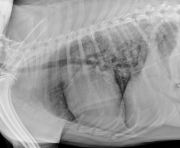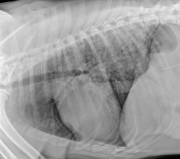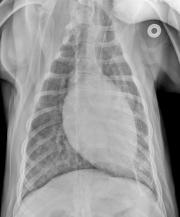Today’s case is a 6 year old male neutered German Shepherd with anorexia. He was diagnosed with renal failure at the emergency veterinary clinic and referred for diagnostics and treatment. Post your interpretations in the comments!
Case originally posted on May 22, 2009



There is a diffuse peribronchial and interstitial lung pattern in the middle and caudal lung lobes on both sides. The is a small amount of fluid in the pleural cavity. The heart silhouette is without normal limits. Lung vessels seem to be widened. It could be a pneumonia due to chemical intoxication.
The answers are already there but I tried to interpret the images before I read your comments. So here it is. I thought that the predominant pattern was interstitial although has also a alveolar pattern. Definitively the caudo dorsal lung lobes were more affected. Given the history of acute renal failure the first thought that came to my mind was fluid overload vs PLN with secondary leakage of fluids. Pneumonitis was not in my differentials (so good thing I read your interpretation). In retrospective (after I read your interpretation). Pulmonary vessels appeared full but not severely enlarged( potentially ruling out fluid overload) and Leakage usually occurs in pleural space or peritoneal space (which do not appear to be present in significant amounts). I have two questions do you have a recent article that I can read about pneumonitis specifically uremic pneumonitis, and also is there also information about the technique for vena cava catheterization ( does it have an proper name ?). Thank you again
Those are good observations. Textbooks might be the most helpful source of information on pneumonitis, such as the BSAVA manual of thoracic imaging listed under the resources section.